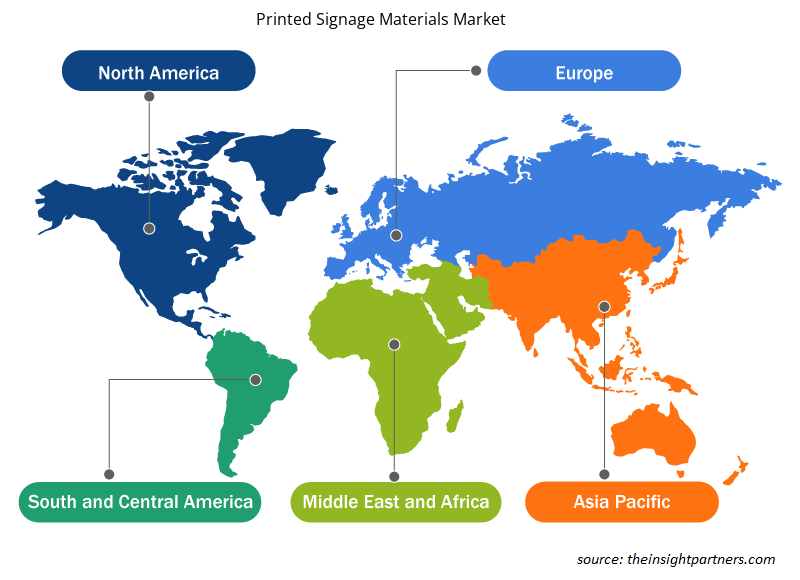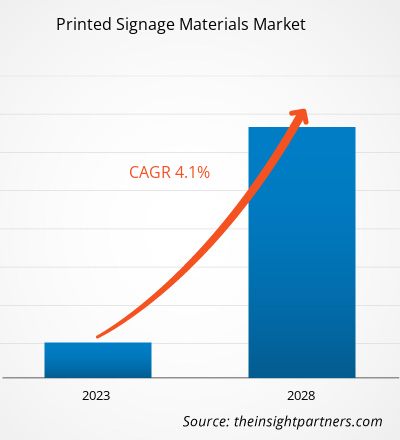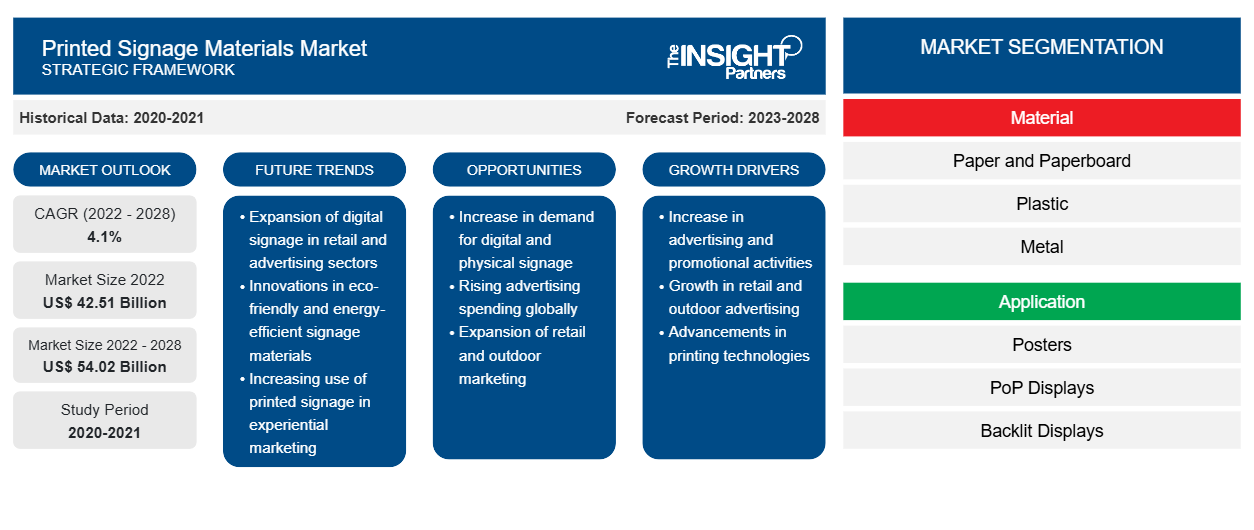印刷标牌材料市场规模预计将从 2022 年的 425.1242 亿美元增长到 2028 年的 540.1534 亿美元;预计 2022 年至 2028 年的复合年增长率为 4.1%。
印刷标牌是最有效和最高效的广告类型之一。它是零售店用来销售产品的必备工具。各家公司不断寻找推广品牌的最佳方式。室内和室外印刷广告因其高可见度而具有重要意义。设计精良、位置合适的印刷标牌可以激励购物者使用不同的产品。大幅面印刷有助于创造高影响力的视觉效果,并带来信息和促销广告。
2022 年,亚太地区占据了全球印刷标牌材料市场的最大份额。亚太地区的市场分为澳大利亚、中国、印度、日本、韩国和亚太地区其他地区。在该地区,各行各业高度依赖印刷标牌来宣传和营销其品牌。娱乐、制造、物流和零售等关键行业需要大量标牌来推广其产品。此外,标牌维护成本较低、这种营销方式效率高,再加上印度和中国等发展中国家的快速城市化,加速了该地区印刷标牌材料市场的增长。此外,亚太市场中的各家公司都在推出新产品,以先进和精致的设计为客户提供更广泛的选择。这一策略有助于新进入者为自己创造巨大的市场机会。2021 年 4 月,Colorje 推出了 SoniQ I 标牌打印机,以扩大其标牌打印机阵容。
定制此报告以满足您的需求
您可以免费定制任何报告,包括本报告的部分内容、国家级分析、Excel 数据包,以及为初创企业和大学提供优惠和折扣
- 获取此报告的关键市场趋势。这个免费样品将包括数据分析,从市场趋势到估计和预测。
COVID-19 疫情对印刷标牌材料市场的影响
COVID-19 疫情对化学品和材料行业的增长产生了不利影响,进而阻碍了印刷标牌材料市场的表现。为抗击 SARS-CoV-2 传播而采取的措施对各行业的增长产生了负面影响。由于国内和国际边界突然关闭,体育和娱乐、银行、运输和物流等行业的运营效率突然下降,价值链中断,这些行业受到了阻碍。2020 年实施的封锁迫使企业暂停运营,从而减少了印刷标牌和相关印刷材料的使用。在疫情期间,对小册子、传单、展位面板、海报、墙贴和标牌的需求下降。
然而,医院、机场和其他紧急服务对印刷标牌的需求有所增加。此外,在 2021 年,随着各种零售店、活动场所和其他公共场所的重新开放,不同国家对印刷标牌材料的需求有所增加。
市场洞察
零售业对印刷标牌的需求不断增长推动市场增长
根据美国人口普查局 2021 年度零售贸易调查 (ARTS) 的最新估计,美国零售额增长了 17.1%,从 2020 年的 5,5720 亿美元增至 2021 年的 6,5226 亿美元。在零售领域,印刷标牌用于品牌营销和产品识别。印刷标牌广泛用于销售点展示、横幅、海报、背光广告牌、图形、围板和其他展示图案和信息板,用于广告产品以吸引顾客并扩大他们对产品的了解。室内零售标牌和室外零售标牌是零售标牌的类型。室内零售标牌旨在说服顾客进行购买,并将顾客引导至商店中的特定位置,例如更衣室和洗手间。室外零售标牌用于创建最新的引人入胜的邀请。对外部印刷标牌的需求在增加,因为它们有助于吸引顾客进入商店。
此外,根据标牌基金会的数据,标牌对销售有显著的积极影响,超过 60% 的企业报告称,通过增加或更新标牌,销售额增长了 10%。户外广告媒体(如广告牌和海报)的使用率不断上升,推动了对印刷标牌材料的需求。
材料洞察
根据材料,全球印刷标牌材料市场细分为纸张和纸板、塑料、金属和其他。塑料部分在 2022 年占据了最大的印刷标牌材料市场份额。塑料用于许多不同的标牌应用,包括热成型标牌面、餐厅菜单板以及寻路和识别牌。亚克力标牌用于公司徽标;高光泽海报用于展示公司的产品和材料;以及促销标志、方向标志和悬挂标志。此外,聚氯乙烯 (PVC) 可以形成任何尺寸、厚度和颜色的平板。因此,由塑料制成的标牌用途广泛、坚固、轻便、耐用且价格实惠。
应用程序洞察
根据应用,全球印刷标牌材料市场细分为海报、PoP 显示器、背光显示器、广告牌横幅、旗帜和背景、车辆/车队图形等。海报部分在 2022 年占据了印刷标牌材料最大的市场份额。企业可以通过多种方式与目标消费者沟通,但使用大型海报是最有益的沟通方式之一。海报是在公共场所展示的大型印刷图片或通知,通常用于户外广告。海报可以通过清晰地显示相关内容来有效吸引观众。此外,通过海报做广告只需要少数人的参与。
3A Composites GmbH、Avery Dennison Corp、IGEPA group GmbH & Co KG、Spandex AG、Lintec Europe (UK) Ltd、ORAFOL Europe GmbH、Vink Holdings Ltd、Thyssenkrupp Materials Services GmbH、Antalis 和 Inapa Investimentos Particip Gestao SA 是全球印刷标牌材料市场的主要参与者。市场参与者专注于提供高质量的产品以满足客户需求。他们还采取了投资研发活动和新产品发布等策略。
印刷标牌材料市场区域洞察
Insight Partners 的分析师已详尽解释了预测期内影响印刷标牌材料市场的区域趋势和因素。本节还讨论了北美、欧洲、亚太地区、中东和非洲以及南美和中美洲的印刷标牌材料市场细分和地理位置。

- 获取印刷标牌材料市场的区域特定数据
印刷标牌材料市场报告范围
| 报告属性 | 细节 |
|---|---|
| 2022 年市场规模 | 425.1亿美元 |
| 2028 年市场规模 | 540.2亿美元 |
| 全球复合年增长率(2022 - 2028) | 4.1% |
| 史料 | 2020-2021 |
| 预测期 | 2023-2028 |
| 涵盖的领域 | 按材质
|
| 覆盖地区和国家 | 北美
|
| 市场领导者和主要公司简介 |
|
印刷标牌材料市场参与者密度:了解其对业务动态的影响
印刷标牌材料市场正在快速增长,这得益于终端用户需求的不断增长,而这些需求又源于消费者偏好的不断变化、技术进步以及对产品优势的认识不断提高等因素。随着需求的增加,企业正在扩大其产品范围,进行创新以满足消费者的需求,并利用新兴趋势,从而进一步推动市场增长。
市场参与者密度是指在特定市场或行业内运营的企业或公司的分布情况。它表明在给定市场空间中,相对于其规模或总市场价值,有多少竞争对手(市场参与者)存在。
在印刷标牌材料市场运营的主要公司有:
- 3A复合材料有限公司
- 艾利丹尼森公司
- IGEPA 集团有限公司
- 斯潘德克斯公司
- Lintec 欧洲(英国)有限公司
免责声明:上面列出的公司没有按照任何特定顺序排列。

- 获取印刷标牌材料市场顶级关键参与者概览
报告亮点
- 印刷标牌材料市场的渐进式行业趋势可帮助参与者制定有效的长期战略
- 发达市场和发展中市场采用的业务增长战略
- 2020 年至 2028 年印刷标牌材料市场的定量分析
- 全球印刷标牌材料需求量估计
- 波特五力分析说明了行业内买家和供应商的效力
- 了解竞争市场状况的最新发展
- 市场趋势和前景,以及推动和抑制印刷标牌材料市场增长的因素
- 通过强调支撑商业利益的市场策略来协助决策过程,从而促进市场增长
- 不同节点的印刷标牌材料市场规模
- 市场的详细概述和细分,以及印刷标牌材料行业动态
- 各地区印刷标牌材料市场规模及增长机遇
全球印刷标牌材料市场
根据材料,印刷标牌材料市场分为纸张和纸板、塑料、金属和其他。根据应用,市场分为海报、PoP 显示器、背光显示器、广告牌横幅、旗帜和背景、车辆/车队图形和其他。根据最终用途行业,全球印刷标牌材料市场分为 BFSI、零售、运输和物流、医疗保健、体育和娱乐和其他。
公司简介
- 3A复合材料有限公司
- 艾利丹尼森公司
- IGEPA 集团有限公司
- 斯潘德克斯公司
- Lintec 欧洲(英国)有限公司
- ORAFOL 欧洲有限公司
- 温克控股有限公司
- 蒂森克虏伯材料服务有限公司
- 安塔利斯
- Inapa Investimentos 参与 Gestao SA。
- 历史分析(2 年)、基准年、预测(7 年)及复合年增长率
- PEST和SWOT分析
- 市场规模、价值/数量 - 全球、区域、国家
- 行业和竞争格局
- Excel 数据集
近期报告
相关报告
客户评价
购买理由
- 明智的决策
- 了解市场动态
- 竞争分析
- 客户洞察
- 市场预测
- 风险规避
- 战略规划
- 投资论证
- 识别新兴市场
- 优化营销策略
- 提升运营效率
- 顺应监管趋势





















 获取免费样品 - 印刷标牌材料市场
获取免费样品 - 印刷标牌材料市场